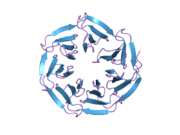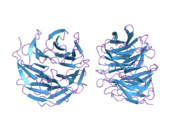WDR5
| View/Edit Human | View/Edit Mouse |
WD repeat-containing protein 5 is a protein that in humans is encoded by the WDR5 gene.[3][4]
This gene encodes a member of the WD repeat protein family. WD repeats are minimally conserved regions of approximately 40 amino acids typically bracketed by gly-his and trp-asp (GH-WD), which may facilitate formation of heterotrimeric or multiprotein complexes. Members of this family are involved in a variety of cellular processes, including cell cycle progression, signal transduction, apoptosis, and gene regulation. This protein contains 7 WD repeats. Alternatively spliced transcript variants encoding the same protein have been identified.[4]
Interactions
WDR5 has been shown to interact with Host cell factor C1[5][6] and MLL.[5] It also interacts with the long non-coding RNA HOTTIP.[7] WDR5 is a key determinant for MYC recruitment to chromatin[8]
References
- ↑ "Human PubMed Reference:".
- ↑ "Mouse PubMed Reference:".
- ↑ Gori F, Divieti P, Demay MB (Dec 2001). "Cloning and characterization of a novel WD-40 repeat protein that dramatically accelerates osteoblastic differentiation". J Biol Chem. 276 (49): 46515–22. doi:10.1074/jbc.M105757200. PMID 11551928.
- 1 2 "Entrez Gene: WDR5 WD repeat domain 5".
- 1 2 Yokoyama, Akihiko; Wang Zhong; Wysocka Joanna; Sanyal Mrinmoy; Aufiero Deborah J; Kitabayashi Issay; Herr Winship; Cleary Michael L (Jul 2004). "Leukemia proto-oncoprotein MLL forms a SET1-like histone methyltransferase complex with menin to regulate Hox gene expression". Mol. Cell. Biol. United States. 24 (13): 5639–49. doi:10.1128/MCB.24.13.5639-5649.2004. ISSN 0270-7306. PMC 480881
 . PMID 15199122.
. PMID 15199122. - ↑ Wysocka, Joanna; Myers Michael P; Laherty Carol D; Eisenman Robert N; Herr Winship (Apr 2003). "Human Sin3 deacetylase and trithorax-related Set1/Ash2 histone H3-K4 methyltransferase are tethered together selectively by the cell-proliferation factor HCF-1". Genes Dev. United States. 17 (7): 896–911. doi:10.1101/gad.252103. ISSN 0890-9369. PMC 196026
 . PMID 12670868.
. PMID 12670868. - ↑ Wang KC, Yang YW, Liu B, Sanyal A, Corces-Zimmerman R, Chen Y, et al. (2011). "A long noncoding RNA maintains active chromatin to coordinate homeotic gene expression.". Nature. 472 (7341): 120–4. doi:10.1038/nature09819. PMID 21423168.
- ↑ Thomas, L. R.; Tansey, W. P. (2015). "Interaction with WDR5 Promotes Target Gene Recognition and Tumorigenesis by MYC". Molecular Cell. 58 (3): 1–13. doi:10.1016/j.molcel.2015.02.028. PMC 4427524
 . PMID 25818646.
. PMID 25818646.
Further reading
- Strausberg RL, Feingold EA, Grouse LH, et al. (2003). "Generation and initial analysis of more than 15,000 full-length human and mouse cDNA sequences.". Proc. Natl. Acad. Sci. U.S.A. 99 (26): 16899–903. doi:10.1073/pnas.242603899. PMC 139241
 . PMID 12477932.
. PMID 12477932. - Wysocka J, Myers MP, Laherty CD, et al. (2003). "Human Sin3 deacetylase and trithorax-related Set1/Ash2 histone H3-K4 methyltransferase are tethered together selectively by the cell-proliferation factor HCF-1.". Genes Dev. 17 (7): 896–911. doi:10.1101/gad.252103. PMC 196026
 . PMID 12670868.
. PMID 12670868. - Gori F, Demay MB (2004). "BIG-3, a novel WD-40 repeat protein, is expressed in the developing growth plate and accelerates chondrocyte differentiation in vitro.". Endocrinology. 145 (3): 1050–4. doi:10.1210/en.2003-1314. PMID 14657013.
- Ota T, Suzuki Y, Nishikawa T, et al. (2004). "Complete sequencing and characterization of 21,243 full-length human cDNAs.". Nat. Genet. 36 (1): 40–5. doi:10.1038/ng1285. PMID 14702039.
- Yokoyama A, Wang Z, Wysocka J, et al. (2004). "Leukemia proto-oncoprotein MLL forms a SET1-like histone methyltransferase complex with menin to regulate Hox gene expression.". Mol. Cell. Biol. 24 (13): 5639–49. doi:10.1128/MCB.24.13.5639-5649.2004. PMC 480881
 . PMID 15199122.
. PMID 15199122. - Gerhard DS, Wagner L, Feingold EA, et al. (2004). "The status, quality, and expansion of the NIH full-length cDNA project: the Mammalian Gene Collection (MGC).". Genome Res. 14 (10B): 2121–7. doi:10.1101/gr.2596504. PMC 528928
 . PMID 15489334.
. PMID 15489334. - Andersen JS, Lam YW, Leung AK, et al. (2005). "Nucleolar proteome dynamics.". Nature. 433 (7021): 77–83. doi:10.1038/nature03207. PMID 15635413.
- Wysocka J, Swigut T, Milne TA, et al. (2005). "WDR5 associates with histone H3 methylated at K4 and is essential for H3 K4 methylation and vertebrate development.". Cell. 121 (6): 859–72. doi:10.1016/j.cell.2005.03.036. PMID 15960974.
- Dou Y, Milne TA, Tackett AJ, et al. (2005). "Physical association and coordinate function of the H3 K4 methyltransferase MLL1 and the H4 K16 acetyltransferase MOF.". Cell. 121 (6): 873–85. doi:10.1016/j.cell.2005.04.031. PMID 15960975.
- Rual JF, Venkatesan K, Hao T, et al. (2005). "Towards a proteome-scale map of the human protein-protein interaction network.". Nature. 437 (7062): 1173–8. doi:10.1038/nature04209. PMID 16189514.
- Gori F, Friedman L, Demay MB (2006). "Wdr5, a novel WD repeat protein, regulates osteoblast and chondrocyte differentiation in vivo.". Journal of musculoskeletal & neuronal interactions. 5 (4): 338–9. PMID 16340128.
- Lim J, Hao T, Shaw C, et al. (2006). "A protein-protein interaction network for human inherited ataxias and disorders of Purkinje cell degeneration.". Cell. 125 (4): 801–14. doi:10.1016/j.cell.2006.03.032. PMID 16713569.
- Ruthenburg AJ, Wang W, Graybosch DM, et al. (2006). "Histone H3 recognition and presentation by the WDR5 module of the MLL1 complex.". Nat. Struct. Mol. Biol. 13 (8): 704–12. doi:10.1038/nsmb1119. PMID 16829959.
- Couture JF, Collazo E, Trievel RC (2006). "Molecular recognition of histone H3 by the WD40 protein WDR5.". Nat. Struct. Mol. Biol. 13 (8): 698–703. doi:10.1038/nsmb1116. PMID 16829960.
- Dou Y, Milne TA, Ruthenburg AJ, et al. (2006). "Regulation of MLL1 H3K4 methyltransferase activity by its core components.". Nat. Struct. Mol. Biol. 13 (8): 713–9. doi:10.1038/nsmb1128. PMID 16878130.
- Schuetz A, Allali-Hassani A, Martín F, et al. (2006). "Structural basis for molecular recognition and presentation of histone H3 by WDR5.". EMBO J. 25 (18): 4245–52. doi:10.1038/sj.emboj.7601316. PMC 1570438
 . PMID 16946699.
. PMID 16946699. - Ewing RM, Chu P, Elisma F, et al. (2007). "Large-scale mapping of human protein-protein interactions by mass spectrometry.". Mol. Syst. Biol. 3 (1): 89. doi:10.1038/msb4100134. PMC 1847948
 . PMID 17353931.
. PMID 17353931.

















